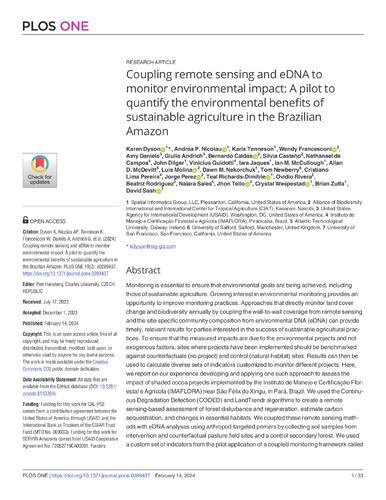Coupling remote sensing and eDNA to monitor environmental impact: A pilot to quantify the environmental benefits of sustainable agriculture in the Brazilian Amazon
Monitoring is essential to ensure that environmental goals are being achieved, including those of sustainable agriculture. Growing interest in environmental monitoring provides an opportunity to improve monitoring practices. Approaches that directly monitor land cover change and biodiversity annually by coupling the wall-to-wall coverage from remote sensing and the site-specific community composition from environmental DNA (eDNA) can provide timely, relevant results for parties interested in the success of sustainable agricultural practices. To ensure that the measured impacts are due to the environmental projects and not exogenous factors, sites where projects have been implemented should be benchmarked against counterfactuals (no project) and control (natural habitat) sites. Results can then be used to calculate diverse sets of indicators customized to monitor different projects. Here, we report on our experience developing and applying one such approach to assess the impact of shaded cocoa projects implemented by the Instituto de Manejo e Certificação Florestal e Agrícola (IMAFLORA) near São Félix do Xingu, in Pará, Brazil. We used the Continuous Degradation Detection (CODED) and LandTrendr algorithms to create a remote sensing-based assessment of forest disturbance and regeneration, estimate carbon sequestration, and changes in essential habitats. We coupled these remote sensing methods with eDNA analyses using arthropod-targeted primers by collecting soil samples from intervention and counterfactual pasture field sites and a control secondary forest. We used a custom set of indicators from the pilot application of a coupled monitoring framework called TerraBio. Our results suggest that, due to IMAFLORA’s shaded cocoa projects, over 400 acres were restored in the intervention area and the community composition of arthropods in shaded cocoa is closer to second-growth forests than that of pastures. In reviewing the coupled approach, we found multiple aspects worked well, and we conclude by presenting multiple lessons learned.

